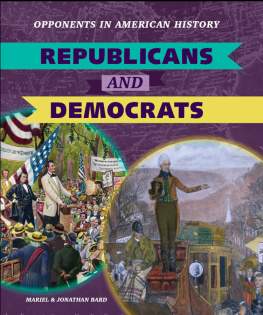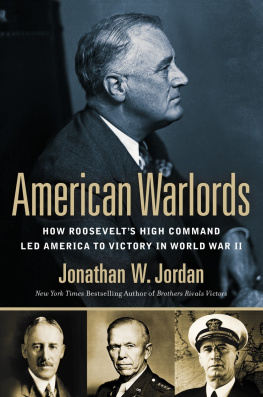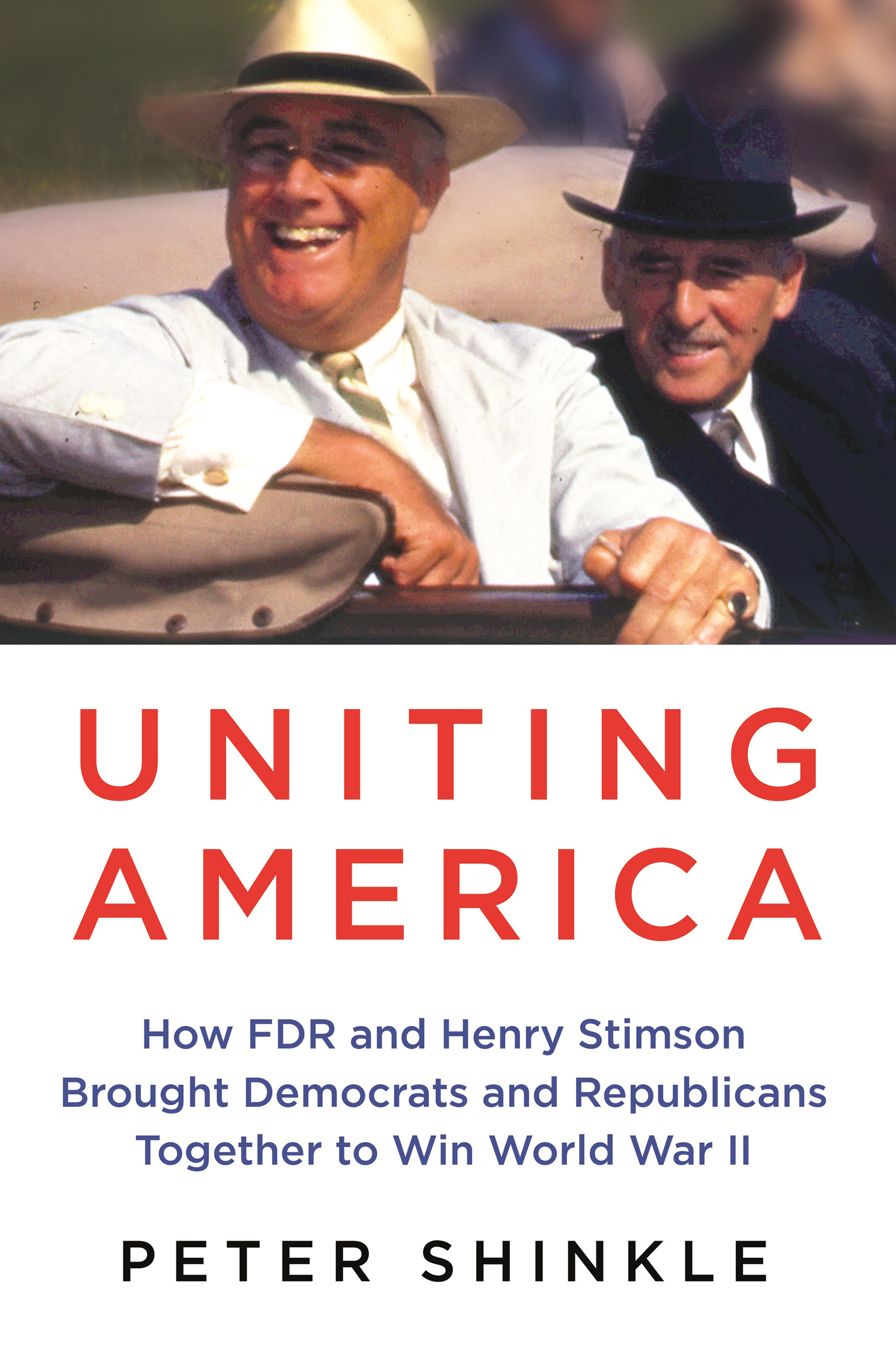Contents
Guide
Pagebreaks of the print version

The author and publisher have provided this e-book to you for your personal use only. You may not make this e-book publicly available in any way. Copyright infringement is against the law. If you believe the copy of this e-book you are reading infringes on the authors copyright, please notify the publisher at: us.macmillanusa.com/piracy.
To all patriotic Americansof any political partywho have the integrity to search for the truth, the honesty to say that an opponent is right and the courage to cross partisan lines for the good of the country and democracy
DEMOCRATS
FRANKLIN D. ROOSEVELT
President
HENRY WALLACE
Vice President 19411945
HARRY TRUMAN
Elected Vice President 1944
President 19451953
HENRY MORGENTHAU JR.
Secretary of the Treasury
HARRY HOPKINS
Special Assistant to FDR
FRANCIS BIDDLE
Attorney General
ELEANOR ROOSEVELT
First Lady
Unofficial Adviser to the President
Associate Director, Office of Civilian Defense
CORDELL HULL
Secretary of State 19331944
JAMES BYRNES
Secretary of State 19451947
Director, Office of War Mobilization 19431945
REPUBLICANS
FRANK KNOX
Secretary of the Navy
WENDELL WILLKIE
GOP Presidential Nominee 1940
WILLIAM DONOVAN
Director, Office of Strategic Services (OSS)
ALLEN DULLES
OSS Switzerland Director
FIORELLO LA GUARDIA
Director, Office of Civilian Defense
Mayor of New York
NELSON ROCKEFELLER
Assistant Secretary of State
JOHN WINANT
Ambassador to the United Kingdom
PATRICK HURLEY
Ambassador to China
HAROLD ICKES
Interior Secretary
HENRY L. STIMSON
Secretary of War
War Department Appointees
ROBERT PATTERSON
Undersecretary of War
ROBERT LOVETT
Assistant Secretary of War for Air
JOHN MCCLOY
Assistant Secretary of War
HARVEY BUNDY
Assistant to the Secretary of War
COLONEL ROBERT CUTLER
Coordinator of Soldier Voting
CHARLES TAFT
US Community War Service
WILLIAM KNUDSEN
Director, Office of Production Management
JOHN OBRIAN
General Counsel, Office of Production Management
With the exception of Willkie and Cutler, all these Republicans sought positions with the Roosevelt Administration prior to the Pearl Harbor attack on December 7, 1941.
After tearing through Belgium, the Netherlands and France, Adolf Hitlers armies had surrounded British and allied troops at Dunkirk in early June 1940. Fearing Germany would attack Great Britain next, Prime Minister Winston Churchill appealed to President Franklin D. Roosevelt for arms so the British could defend themselves from Nazi fascism. In America, however, isolationists bitterly condemned FDR, accusing him of dragging the United States into another costly European war. On June 3, Representative Hamilton Fish, a New York Republican and ardent isolationist, took the floor of the House of Representatives and hurled a rhetorical bomb, suggesting that Democrats were encouraging FDR to set up a dictatorial government in the United States.
Amid a drumbeat of attacks on FDRs war policies, the Republican Party prepared to select a presidential nominee at its national convention in Philadelphia in late June 1940. If a staunch isolationist won the election that fall, America might refuse to send aid to any allies; the prospect of a Nazi empire spanning all of Europe loomed.
On June 20, 1940, FDR launched a bold strategy to undercut the isolationists. In a surprise announcement, he appointed two prominent Republicansboth strong supporters of aiding Americas European alliesto critical posts in his cabinet. Henry L. Stimson, who had been secretary of state under FDRs Republican predecessor, President Herbert Hoover, would be secretary of war, and Frank Knox, the Republican vice-presidential nominee in 1936, would be secretary of the navy. The White House said the appointments, setting partisan politics aside in the name of defending the country, were intended to create national solidarity.
By their example, Stimson and Knox encouraged other Republicans to support the Democratic president. The appointments immediately set off an uproar among Republicans. On the day of FDRs announcement, Republicans lambasted Stimson and Knox at their national convention. They were, some said, read out of the party and no longer spoke for it. Yet days later, in a stunning volte-face, the convention rejected the leading isolationist candidate and instead chose Wendell Willkie, whose war policy was closest to FDRs, as the partys 1940 presidential nominee.
The Stimson and Knox appointments were a daring and risky move that placed a bipartisan political relationship at the very center of Americas defense against fascism. The gamble paid off. Stimson and Knox cultivated an appearance of nonpartisan leadership, and their support ultimately helped FDR win the 1940 presidential election. The nations capital gained a new spirit of solidarity, and many bills passed Congress over the next five years with strong backing from both parties. The bipartisan coalition worked effectively to unite the nation, rapidly expand and strengthen the American military and secure victory in World War II.
Stimson, despite his relatively advanced agehe accepted FDRs appointment at seventy-twospearheaded the bipartisan alliance and carried it through the end of the war. Other prominent Republicans soon joined forces with FDR, including his recent opponent Willkie, New York City mayor Fiorello La Guardia and William Donovan, who was appointed to lead the Office of Strategic Services, the wartime spy agency. Each of these men chose to stand with FDR to defend democracy at a time when doing so meant losing favor with large numbers of Republicans.
The alliance was in full swing long before the December 1941 attack on Pearl Harbor spurred the nation to widely support the war effort and abandon isolationism. It arose at a time when isolationists held sway in Congress and blocked preparations for wara time when it was not easy for Republicans to side with the Democratic president. Yet even after Pearl Harbor, FDR found significant benefits in bipartisanship and sought to work with more Republicans as the war went on. He even imagined a future in which liberals in the Republican Party would convert to the Democratic Party, which would in turn send its conservatives over to the Republicans.
This embrace of bipartisanshipas Hitlers war machine savaged Western Europestands as an act of audacity and brilliance that was instrumental in leading America and her allies to victory in World War II. Yet it has been all but forgotten. One reason for this national amnesia is that FDR and Stimson were so skilled at creating unity that their party differences faded into the background. Another is that political partisans typically attract adherents and campaign contributions by demonizing their opponents as irrational and intransigentnot by celebrating shared goals achieved through collaboration with opposing parties. There is an old saying that success has many fathers, but failure is an orphan. To this one might add: compromise, even for the national good, is a neglected child.







